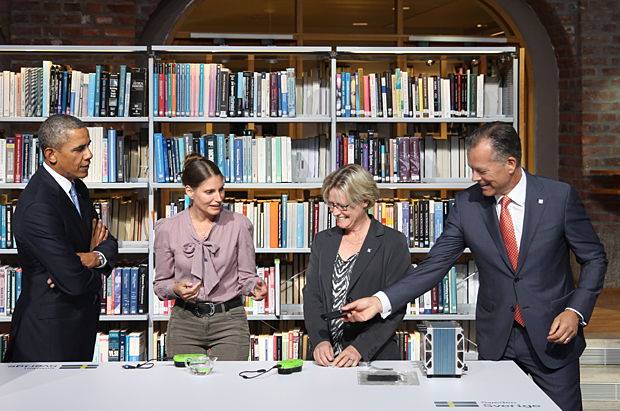KTH shares spotlight with Obama
News
For 10 minutes on Wednesday fuel cells researchers from KTH Royal Institute of Technology shared centre stage in the university library with U.S. President Barack Obama.

With a hydrogen-powered test vehicle, a mobile phone charger and a technology that creates fuel from waste, Göran Lindbergh, Rakel Wreland Lindström and Carina Lagergren took turns demonstrating ways fuel cells can eventually replace fossil fuels.
Accompanied by Swedish Prime Minster Fredrik Reinfeldt, Obama entered the library shortly after 4:30 p.m., and the two leaders were welcomed by KTH President Peter Gudmundson.
In addition to KTH’s fuel cells research, two other stations showcased a water purification system by the Swedish company Solvatten and Swedish automobile and truck manufacturer AB Volvo’s hybrid bus engine.

After viewing the water system, Obama turned his attention to the team from the School of Chemical Science and Engineering at KTH, who showed how they are applying their research to make fuel cells work for people.
The President inspected the student-built Sleipner test vehicle closely, crouching down to examine its motor. Eyeing the compact driver’s seat, he joked to a reporter standing nearby: “You could get in this but not me.”
Lindbergh stressed the efforts to reduce weight and improve performance, for both fuel cells and batteries. He told the President that the two are natural companions in power systems.
Obama, clearly interested in the potential to make the technology practical and affordable to the masses, asked Lindbergh: “Is there any way to apply Moore’s law to these?”
“We’re working on it,” replied Lindbergh.

Wreland Lindström showed Obama the PowerTrekk mobile charger, a fuel-cell device that can recharge a mobile battery using only a couple of teaspoons of ordinary water.
The President leaned in to watch as she poured water into the device and started the charge. Suggesting that the concept could be applied on a larger scale, the President provided the team a perfect segue into the next item, a demonstration by Lagergren of a fuel cell that is 1,000 times more powerful than the PowerTrekk and powered by residue from olive oil production. She explained to Obama that fuel cell technology can also be scaled up for use in stationary power production, to serve facilities that need uninterrupted power, including hotels, hospitals and data centers.
“You’re doing great work,” the President told the three researchers, before moving on to the final station.
After Obama’s departure, Wreland Lindström said she was honoured to have a chance to present KTH research to the President. “It’s great that our area of fuel cells is in the news and that environmental and energy technology is interesting to president,” she said. “It is also good for KTH. It shows that our programs are relevant and high quality.”

She said she hoped that the presidential audience would open doors for political and business leaders to understand fuel cells, “that it’s an important technique to get a stake in.”
“Fuel cells will contribute to more sustainable transportation and more efficient energy systems,” she said.
On his way out of the library, Obama autographed a KTH student union flag and a photo of the library. Gudmundson presented the President with a gift of a traditional wooden Dala Horse, and a personally written card.
David Callahan and Peter Larsson

